It has been 22 years since Australia last experienced a technical recession: a dream run by any standards and not a record to be taken lightly.
Recently, warning signs have emerged suggesting that Australia’s luck might finally be running out.
For instance, this month Goldman Sachs released a report significantly downgrading its GDP forecasts for Australia and ascribing a 20% risk that the economy would experience a recession. In a similar vein, Bank of America Merrill Lynch slashed its GDP growth forecast and placed a 25% probability that Australia would fall into recession.
Central to the conundrum facing Australia is the unwinding of the once-in-a-century mining boom. Of particular importance, mining-related capital expenditure (capex), which has risen roughly six-fold relative to GDP since 2003 and more than doubled over the past two years, has peaked and is now likely in terminal decline as mining companies trim their investment plans amid falling commodity prices (see next chart).
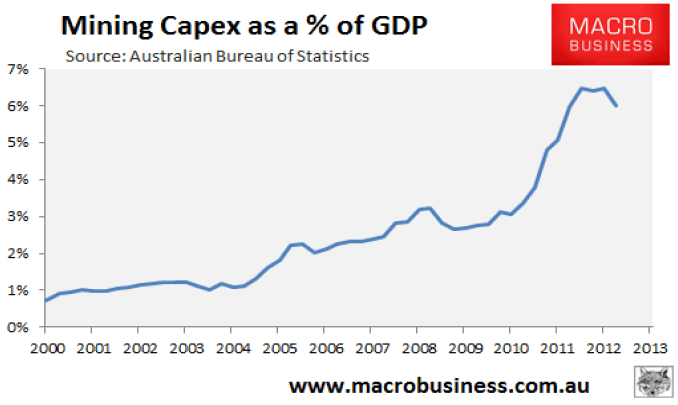
Mining investment has contributed roughly 2% of Australian GDP growth for the last several years. As it falls, it will likely withdraw at least 1% of GDP per annum for the next three years, meaning that Australia would need to find at least 3% of growth elsewhere in the economy to maintain GDP growth at current (subdued) levels.
What’s the real recession risk?
The risk of recession for the next few years is line-ball in our view. If, for example, the economy can generate 1% per annum from mining net exports as new mines come online and 1% per annum from a combination of slowly rising consumption as well as housing construction, then the economy will grind-out anaemic 1% growth and avoid a technical recession. A pre-emptive expansion in public spending would also boost growth, although such an outcome is in doubt given the constant rumblings about excessive government spending and debt from the Abbott-led Coalition.
It is a moot point whether 1-2% growth is enough to avert an actual recession. An anaemic growth period leaves the economy vulnerable to any further shocks, like for instance a big rise in global bond yields or a sudden slowing in Chinese growth or a big fall in the iron ore price. One or all of these is distinctly possible in the next two years.
Indeed, this week we saw the potential for all three. We remain sceptical that Ben Bernanke will be able to withdraw stimulus any time soon because the backup in global bond yields is already fast and steep enough to threaten US housing and global growth.
Also last week, we saw the seriousness of Chinese authorities’ determination to slow unbalanced growth when the PBOC allowed the Chinese interbank market to freeze.
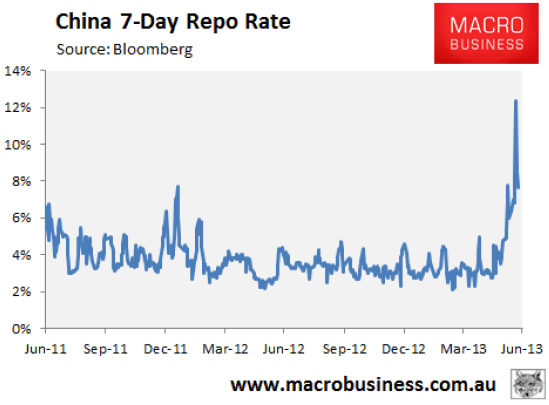
The tightening appears to be a controlled policy experiment but accepting that that’s the case still leaves the high likelihood that Chinese growth is going to slow further this year and next, probably into the vicinity of 6-6.5%%. This will leave Australia’s bulk commodities facing a combined shift to oversupply and falling demand and the nation facing a new income shock that will hit corporate profits, government revenue and household income.
Regardless, it will feel like a recession
Even if there is no further shock and Australia manages to avoid a technical recession – i.e. two consecutive quarters of negative growth in real GDP – the coming slowdown will be enduring and feel like a recession for most people.
Although Australia’s real GDP has averaged a respectable 2.4% growth per annum since the onset of the Global Financial Crisis (GFC), and is now 11.4% higher than in September 2008, real per capita GDP has averaged only 0.8% growth per annum, and is only 3.4% higher today than in September 2008 (see next chart).
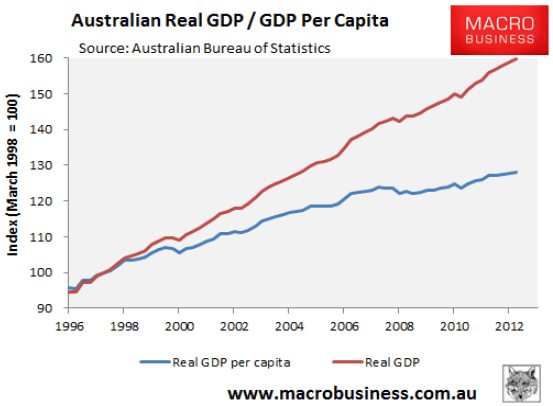
Indeed, growth in real per capita GDP since the onset of the GFC has been weak from an historical perspective, lagging the recoveries following the 1970s, 1980s and 1990s recessions (see next chart).
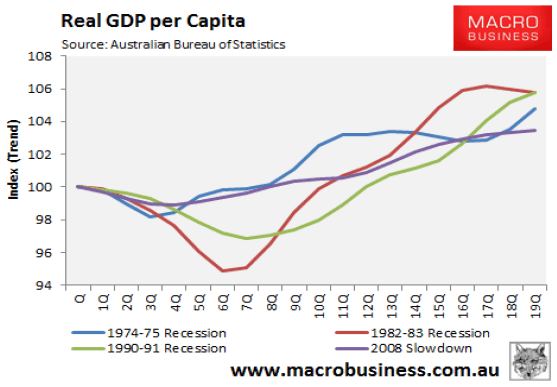
With the economy set to slow significantly as the mining boom unwinds, growth in real per capita GDP is likely to turn negative over the next few years, meaning the average Australian will be going backwards, with growth then likely to remain sub-par for an extended period of time.
Bigger risks are on the horizon for incomes and employment.
According to the Australian Treasury, half of the growth in average incomes over the 2000s was accounted for by the rising terms-of-trade (see next chart).
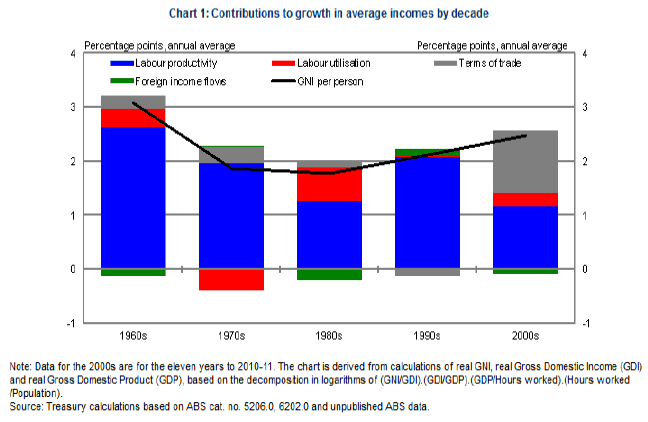
Whereas in prior decades, Australian incomes grew primarily on the back of rising productivity and/or improved labour force participation, over the 2000s they grew because the price of the things that we export – mainly commodities such as iron ore, coal, natural gas, and coal – rose dramatically on the back of China’s insatiable demand for resources.
In turn, Australia effectively received a large pay rise, since more imports could be bought with a given volume of exports. As a result, real average national disposable income (NDI) rose at a much faster rate than justified by the growth of the Australian economy, as measured by real per capita GDP (see next chart).
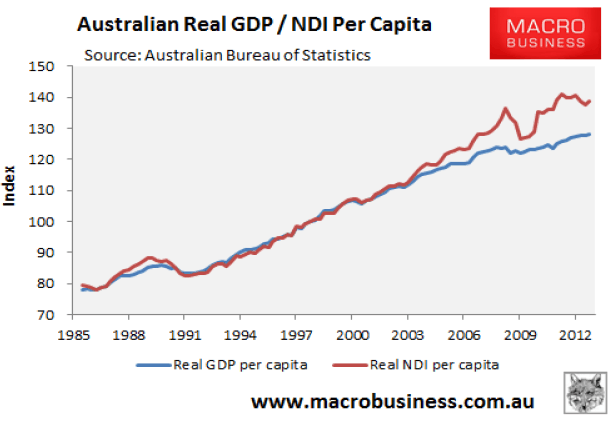
The sharp rise in commodity prices also underpinned government budgets, which reaped the benefit of rising personal and company taxes, as well as resource rent taxes. Some of this extra taxation revenue was also re-distributed to households via tax cuts and welfare payments, thereby further inflating disposable incomes.
The problem going forward is that commodity prices and the terms-of-trade are now falling and will likely continue to do so. This will drag heavily on income growth, with real per capital NDI now likely to grow at a much slower rate than real per capita GDP (i.e. the red line above will converge with the blue line).
Already, real NDI per capita has fallen by nearly 2% over the past five quarters, owing to falling commodity prices and the declining terms-of-trade (see next chart). As the terms-of-trade continues to retrace back towards its longer-run average level, Australia faces the prospect that real incomes will register little to no growth in the decade ahead.
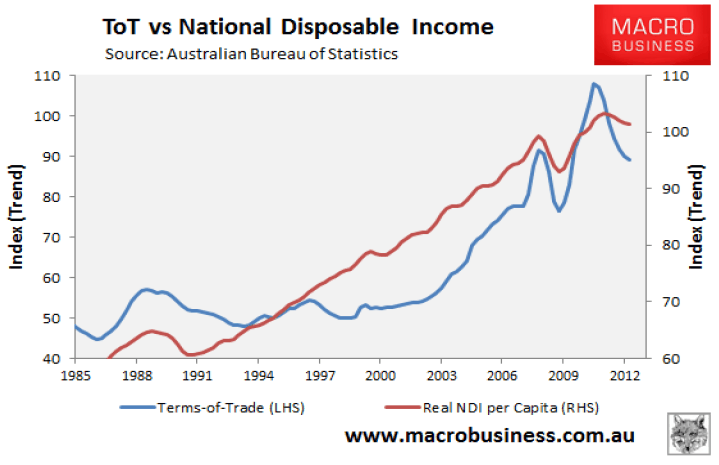
The unwinding of the mining boom is also likely to weigh heavily on the labour market.
According to recent RBA estimates, the mining sector accounts for nearly 10% of Australian employment. Most of these jobs are in areas directly related to mining capex, such as construction workers, engineers, and other mining services. As mining projects finish, so will these jobs, which is likely to lead to a material increase in unemployment unless other areas of the economy can expand sufficiently to fill the void (unlikely in our view).
With mining capex peaking in the September quarter of 2012, we are already witnessing the beginning of the unwinding process, with a large number of mining services firms announcing profit downgrades and job cuts over the past month.
While the pick-up in overall unemployment has so far been fairly modest, it has been masked to some extent by an ongoing deterioration in the labour force participation rate. Moreover, the key mining state of Western Australia is weakening fast on the back of the falling capex and the recent downturn in commodity prices (see next chart).
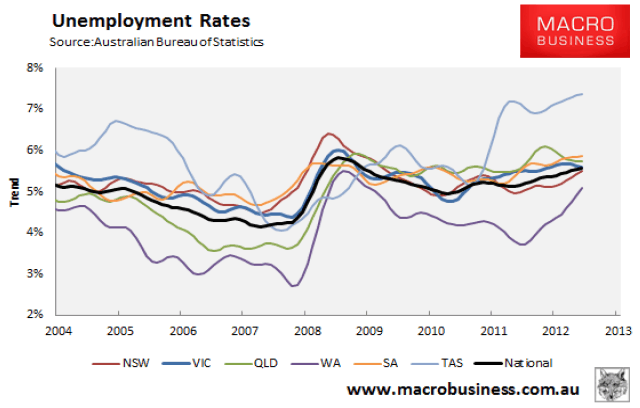
Various job ads surveys are also pointing to ongoing soft labour market conditions and rising unemployment in the months ahead.
Bottom-line
Our current assessment of the next three years suggests that the best case scenario for the Australian economy is a dour struggle against the headwinds of falling mining investment. Growth based upon net exports will still see unemployment slowly climb even if successful.
Moreover, chronically slow growth leaves the Australian economy vulnerable to new shocks that appear probable.
Investors should remain cautious on stocks or property exposed to domestic demand, especially in the former high-flying mining states, despite the dollar and interest rates facing considerable further falls.

